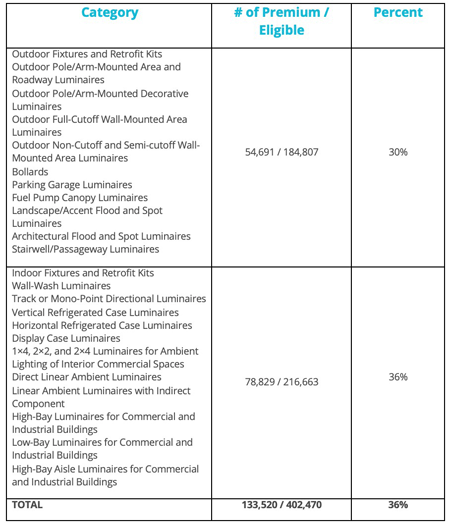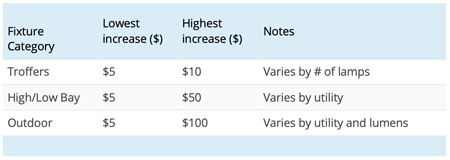Three years into DesignLights Consortium® Premium, with over 130,000 (and growing) products listed, it’s worth exploring why DLC® Premium was initiated, its intended purpose, and whether it’s actually having the desired effect. Also, we’ll take a look at how utilities are handling incentives for premium fixtures, how all energy efficiency players can use the premium distinction to their advantage, and a look into what the future may hold.
Past
In 2015, the DesignLights Consortium finalized and released version 3.0 of its technical requirements, which included a new “DLC Premium” classification for LED luminaires and retrofit kits.
“The DLC Premium classification identifies products with higher performance than those that meet the DLC Standard classification. This change will enable DLC Members to identify the most efficacious products for incentive consideration. Manufacturers of these products will also be able to distinguish themselves on the QPL and also through the use of the new DLC Premium logo.”
At the 2015 DLC Stakeholder meeting, the discussion about the DLC Premium topic was lively and emotional. Many manufacturers expressed their displeasure with the introduction of an additional classification, primarily for two reasons: the cost of reclassifying an already DLC-listed product and the name of the new classification. Utilities, on the other hand, were trying to put a focus on products that achieved greater efficiency. In the end, the concept of DLC Premium proceeded to implementation.
In 2016, version 4.0 was released. This new standard increased the efficacy requirements for both DLC Standard and DLC Premium in an attempt to raise the bar on LED efficacy and what products were being used for energy efficiency products.
“…the DLC has raised the requirements for Premium as well to serve the needs of its membership. The objective for the Premium classification is to identify the top 5-10% most efficacious products in any given category.”
Utility Programs
Starting in 2015, utility programs began to introduce DLC Premium into program design. There have been a number of implementations and iterations since then, including the introduction of a separate QPL in California, a big Premium proponent.
Present
Today, from a product listing perspective, the Premium program is going strong.

Of eligible fixtures currently on the DLC, not including lamps which are not eligible for the Premium distinction, 33% have a high enough efficacy to qualify for Premium. Only 7.2% of qualifying fixtures met this threshold in Spring 2016. Advances in LED technology since the Premium concept was announced have produced an overall increase in efficacy. Without any updates to efficacy requirements since 2016, the percentage of products qualifying for premium has far exceeded the ‘5-10%’ objective.
Utility Programs
Utility programs have primarily implemented the DLC Premium concept in two ways. First, some programs have required DLC Premium fixtures to qualify for a rebate or incentives at all, either for specific categories, or for their entire program. Second, programs have offered differentiated incentives levels for DLC Standard vs DLC Premium.
The list of utility programs that use the DLC Premium distinction in program design includes:
-MassSave (including Eversource, National Grid, and Unitil for electric)
-National Grid – Rhode Island
-Eversource – New Hampshire
-National Grid – Upstate NY
-PSEG/Long Island (although not currently differentiating)
-NYSEG
-Rochester Gas and Electric
-JEA – Jacksonville, FL
-Ameren Illinois
-Bright Energy Solutions – MN, IA, SD, ND
-Pacific Gas & Electric
-Southern California Edison
-San Diego Electric & Gas
-Efficiency Nova Scotia
This is a somewhat disappointing list compared to the number of utilities that offer commercial/industrial LED incentives. However, the list does represent approximately 15% of all US commercial and industrial customers. Additionally, these utilities cover markets with high electricity costs and are some of the largest programs by rebates paid annually. Ignore DLC Premium at your own risk!
But how meaningful is it?
Let’s focus on the programs that offer higher incentives for DLC Premium over DLC Standard, I have aggregated the incentive offerings into popular fixture types. For these three categories, the following table lists the lowest and highest incentive differences between DLC Standard and DLC Premium.

I took a quick look at pricing for these product types on some distributor websites and offer a few observations:
-Premium Troffers don’t look like a great deal, depending on how you attribute the lifetime savings for the new LED fixture
-The additional rebate could be impactful for Premium High Bay fixtures, especially with the additional energy savings and high lumens from more efficient fixtures
-Outdoor premium fixtures seem to be a better deal as well, especially at higher lumen levels
But let’s dive into an almost real-world example:
Let’s assume we are looking at a building in Massachusetts (my old home!). An LED upgrade there would qualify for a rebate from MassSave. We’ll check out the middle of the road upgrade from the above table — High Bays.
Assumptions for the existing condition:
1. Nominal 400W metal halides are used indoors
2. Annual burn hours (hours of use) are 4,000
3. The average cost of electricity for a commercial building in Massachusetts is $0.14 per kWh
Assumptions for the LED upgrade:
Rather than pick a random fixture out of the DLC QPL, I created some representative fixtures from the existing list. To determine a wattage for Standard and Premium fixtures, I looked at the entire DLC catalog for High Bay fixture that were around 19,000 lumens. From that subset of data, the average wattage was:
Standard DLC High Bay @ 19000 : 158 watts (average out of 11,000 fixtures)
Premium DLC High Bay @ 19000 : 135 watts (average out of 9,000 fixtures)
I’ve listed the energy savings, rebate and payback for these two fixtures.

In this scenario the difference between Standard and Premium is pretty compelling and DLC Premium is a win-win for everyone! The customer receives a higher rebate, immediately offsetting the additional cost of the premium fixture. Additionally, the premium fixture provides more energy savings, which turns into a shorter payback period and a greater lifetime financial benefit. The manufacturer and distribution chain get higher revenue, and the utility is able to realize higher savings to meet its energy efficiency goals.
However, there are a lot of variables, which can make this scenario more or less compelling.
1. Electric rates – Higher rates mute the difference compared to the overall electric cost, lower rates make the difference more compelling, but elongate the payback period
2. Rebates – MassSave and other programs have both higher and lower rebates for this scenario and differ for other scenarios and applications
3. Pricing – Different relationships in pricing between the two types of products can warp this model
It’s important to do your own homework here and understand where DLC Premium can be a great tool for selling efficiency. More on this below.
Other Premium Incentive approaches
So far, I’ve focused on the most common approach utilities have taken in regard to DLC Premium incentives, prescriptive adders. However, it is worth mentioning a few other approaches. As mentioned earlier, some only incentivize premium fixtures, making standard fixtures ineligible. One utility is using a higher “watts reduced” rate for DLC Premium fixtures. Another program utilizes Premium in refrigeration lighting only. Lastly (and inexplicably), one program offers rebates for both Standard and Premium in its prescriptive program, but only incentivizes Premium in its upstream/midstream/instant rebate program, but those rebates are significantly lower than its prescriptive program.
Recommendations
Based on all the information and analysis above, I’d like to offer a few recommendations on how to best utilize DLC Premium:
Manufacturers: Do your homework to understand where DLC Premium enhanced rebates are offered and use that information to educate your agents/reps, distributors, and other specifiers that Premium fixtures should be considered. Analyze your pricing to determine where and in what scenarios Premium will give you an advantage. Include Premium differentiation language in your marketing to raise awareness that your products qualify for higher incentives, rewarding purchase of higher efficiency products.
Agents/Rep/Distributors: If you are in an area that offers enhanced rebates for DLC Premium, understand the rebate scenarios for your local programs, and screen that against the DLC Premium list to identify fixtures that would offer compelling ROIs. Work with your manufacturer on pricing, detailing the opportunities your area.
Utilities: Take a hard look at implementing DLC Premium. It should promote the purchase of higher efficiency fixtures in your program. The purchase of higher efficiency fixtures creates higher energy savings per project which expedites progress toward efficiency goals.
Future
Looking forward, I will be curious to see what happens with DLC Premium, with a few scenarios in mind:
1. Efficacy updates. DLC 5.0 is reputed to have some efficacy updates, but it’s unclear whether it will have any impact on DLC Premium. If the DLC and member utilities do adjust Premium efficacies in an attempt to return premium to the “5-10%” state, what will happen? Are there consequences to the dramatic uptick in the number of fixtures that meet Premium requirements?
2. Introduction of new DLC Premium opportunities. As utilities look at their program designs, the creation of new Premium incentives, would generate more opportunities for clever manufacturers/agents/distributors to capitalize.
3. Decrease in DLC Premium opportunities. Honestly, the California programs, which have been big users of the Premium concept, appear to be marginalizing the concept of paying more for higher efficiency. Only one category of lighting has higher incentives for Premium fixtures. We’ll see what the new year brings.
I hope this helps catch everybody up. Please feel free to comment below with questions or to get clarification on this topic.
By Mike Cham, CTO, Encentiv Energy - www.encentivenergy.com
Sources:
All data in this article was sourced from Encentiv Energy’s database.
*Full disclosure: I am the CTO of Encentiv Energy, and I eat my own dog food. |